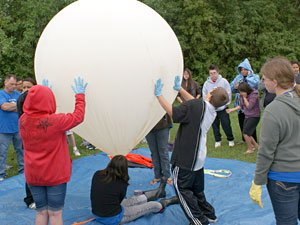Helping students reach higher

Reach for the Sky program offers White Earth students a closer look at STEM disciplines
Keeping middle school kids enthralled with the idea of a career in math, science, or engineering is never an easy task, and it can be even more of a challenge in Native communities. That’s where the Reach for the Sky (RFTS) program comes in.
Reach for the Sky has been a three-year partnership—funded by the National Science Foundation—between the University of Minnesota, the White Earth 21st Century After School Program, and three schools on the White Earth Reservation.
The program brings innovative curricula and activities in STEM disciplines (science, technology, engineering, and mathematics) to the White Earth students over a five-week span. It’s targeted at fourth- through eighth-graders, the age “when students start to lose an interest in science and mathematics,” says RFTS co-director and associate professor Gillian Roehrig.
“What we wanted to do is provide opportunities for students to have hands-on, culturally relevant, place-based opportunities with science and engineering and mathematics that they could relate to—things they could see in their own communities,” Roehrig says. “The goal is to keep students engaged in science and to see that science is a possibility as a career.”
Up, up, and away
Part of the focus of this summer’s program was to study the earth’s atmosphere, and the White Earth students (with the help of aerospace engineering and mechanics professor James Flaten and the U's Minnesota Space Grant High Altitude Ballooning Team) created experimental packages. They included sensors, cameras, and GPS units and were attached to two large helium weather balloons.
The balloon experiments were designed to give students a basic understanding of what the earth’s atmosphere is like, Roehrig says, “so that you can start to talk about how things we do as humans—like pollution—upset the atmosphere.”
The students discovered how temperature, pressure, and radiation are affected by the atmosphere, and also how remote NASA satellites work.
There were surprises along the way. Students discovered that the temperature gets lower and lower at higher altitudes, up to a certain point where an inversion kicks in.
“The temperature actually does something the students would never predict,” Roehrig says.
Because science doesn't have to be separate from culture
While their career choices have yet to be determined, it’s apparent that the White Earth students are embracing the RFTS program, which recently received a grant extension for a fourth year. Each year student interest exceeds the space available in the program, and many students have been in the program all three years.
“We’ve got kids who could be doing something else, but they’re choosing to come here,” Roehrig notes. “You can imagine the squealing and the excitement with the balloon going up and the different things they’re doing.”
The fact that the programming is intended to be culturally relevant to Anishinaabe youth makes it that much more beneficial.
“You don’t want science to be something that’s done to a community,” says Roehrig. “You want the students to see science as something that’s part of them and part of their culture and part of their community. … It’s not ‘I can be Native or I can be a scientist.’”
Reach for the Sky involves faculty from the College of Education and Human Development, the College of Food, Agricultural and Natural Resource Sciences (CFANS), the College of Science and Engineering, and University of Minnesota Extension. In addition to Roehrig, the co-PIs of the program are Tamara Moore, assistant professor in the Department of Curriculum and Instruction, and Stephan Carlson, CFANS professor and Extension educator.
